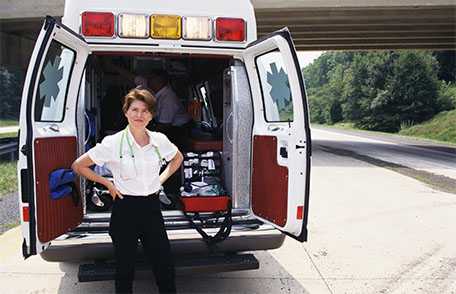Emergency Medical Services: The First Step to Stroke Recovery

Improving Stroke Care in Georgia Recognizing the key role of emergency medical technicians (EMTs) and paramedics in stroke care was a priority for the Georgia Coverdell Acute Stroke Registry (GCASR). “The first person who touches the stroke patient is a part of the health care team, and that’s EMS. We’re really increasing the high level of care patients receive—from initial contact with a health care professional to the point when they’re released from the hospital and sent home.” — GCASR Principal Investigator
Emergency medical services (EMS) professionals, such as paramedics and emergency technicians, are key to a stroke patient’s treatment. Learn how the Coverdell program supports EMS through training and resources.
The Coverdell Program and EMS
The Coverdell program seeks to improve the time it takes for a stroke patient to receive the necessary treatment at the hospital. Improving the quality of care for stroke patients during EMS transport is crucial to improving health outcomes for patients with this time-sensitive condition.
Most strokes are caused by a clot in the brain, which blocks blood flow and causes brain cells to die. A common treatment for this type of stroke is a clot-busting drug, but for most patients, it must be given within 3 hours of having a stroke to be effective. In addition to quickly transporting the patient to a hospital or certified stroke center, EMS professionals ask questions about stroke symptoms and when they started. This information helps the medical team at the hospital act more quickly to administer the clot-busting drug or other treatments that can save a patient’s life and improve recovery time from stroke.
The Coverdell program helps support EMS in this mission. Funded states provide training and resources for hospitals and EMS agencies on collecting and sharing data and ways to improve the patient hand-off at the emergency room. The Coverdell program also helps standardize stroke performance measures across the nation to provide more opportunities for collaboration and learning.

EMS is the “T” in F.A.S.T. These health care professionals are critical to ensuring stroke patients get to the hospital in time for lifesaving treatments.
EMS Success Stories
Partnerships with EMS agencies through the Coverdell program improve the quality of care for stroke patients in many states.
- In 2013, Georgia’s Coverdell Program wrote a set of guidelines [PDF-141K] on stroke care for EMS. Just one year later, stroke patients were receiving potentially lifesaving medicine 8 minutes sooner, on average.
- In 2015 in New York, 7 in 10 stroke patients got a necessary clot-busting drug within 1 hour, compared to 6 in 10 in 2014.
- The Massachusetts Coverdell team developed a patient education program for 344 nursing home and skilled nursing facility employees on the F.A.S.T. assessment [PDF-131K]. The percentage of staff who knew the importance of acting quickly and who could accurately identify symptoms rose from 66% to 94%.
Read more success stories from Coverdell program grantees. Learn more about the important role EMS plays in stroke care.
Resources
- Severity Based Stroke Triage Algorithm [PDF-834K]-American Stroke Association
- Pre-Hospital/Emergency Medical Service (EMS) Course-NINDS Common Data Elements for Stroke
- National Association of Emergency Medical Technicians
- National Association of State EMS Officials
- Page last reviewed: May 16, 2017
- Page last updated: May 16, 2017
- Content source:



 ShareCompartir
ShareCompartir